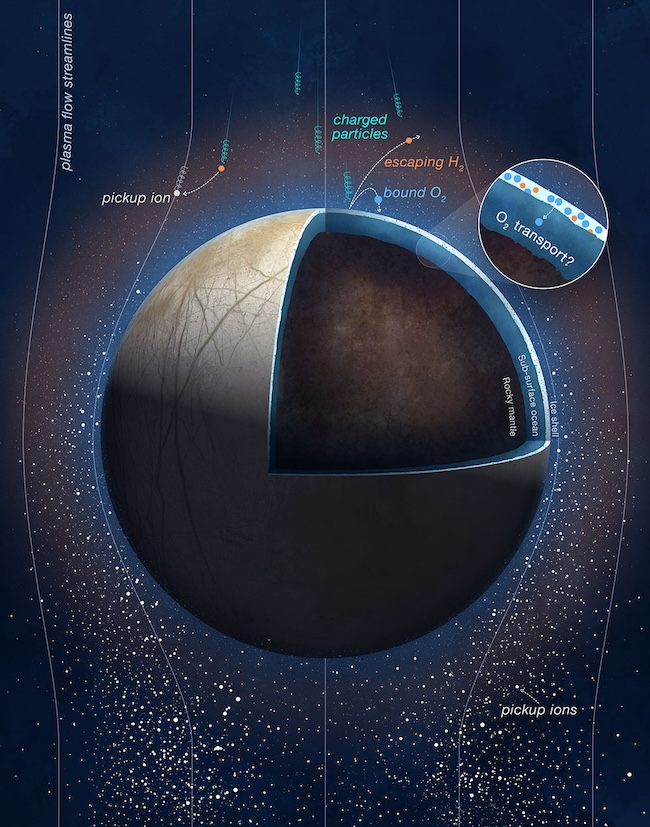
- A new study using data from NASA’s Juno mission reveals Jupiter’s moon Europa generates approximately 1,000 tons of oxygen every 24 hours.
- That much oxygen is sufficient for a million people to breathe daily, though it’s still less oxygen than scientists thought was on Europa.
- The upcoming Europa Clipper mission, launching this year, will arrive at Jupiter in 2030 and use its nine scientific instruments to study the moon’s habitability.
1,000 tons of oxygen every 24 hours
Europa is an ice-covered ocean moon of Jupiter. Ionized (charged) particles from Jupiter impact the moon’s icy surface, splitting water molecules into hydrogen and oxygen. But exactly how much oxygen is in Europa’s thin atmosphere has been a matter of debate. On March 4, 2024, a new study from an international team of scientists with NASA’s Juno mission said they’ve determined the rate of oxygen production on Europa to be about 1,000 tons every 24 hours. That’s enough oxygen for a million people to breathe every day, yet still less than previous studies had estimated. The result also means less oxygen could make its way into the ocean below the surface, possibly affecting habitability.
The researchers published their peer-reviewed results in Nature Astronomy on March 4, 2024.
Europa’s thin atmosphere
Europa is the smallest Galilean moon, about the size of our own moon, but it does have an atmosphere … sort of. It’s extremely thin and tenuous, and scientists often refer to it as an exosphere. The thinnest, outermost part of Earth’s atmosphere is also called the exosphere. On Europa, it’s primarily oxygen with traces of water vapor and hydrogen. Unlike Earth, however, the oxygen isn’t produced mostly by plants on the surface. It’s Jupiter’s ionized (charged) particles hitting the desolate, icy surface that creates oxygen. As lead author Jamey Szalay from Princeton University in New Jersey explained it:
Europa is like an ice ball slowly losing its water in a flowing stream. Except, in this case, the stream is a fluid of ionized particles swept around Jupiter by its extraordinary magnetic field. When these ionized particles impact Europa, they break up the water-ice molecule by molecule on the surface to produce hydrogen and oxygen. In a way, the entire ice shell is being continuously eroded by waves of charged particles washing up upon it.
Oxygen estimates
So, how much oxygen do these impacts generate? Previous estimates ranged from a few pounds to over 2,000 pounds per second (over 1,000 kilograms per second). But the new analysis of data from Juno suggests the production rate of oxygen on Europa is toward the lower end: about 26 pounds per second (12 kilograms per second), or 1,000 tons every 24 hours.
The researchers derived the estimated oxygen production using data from Juno’s Jovian Auroral Distributions Experiment (JADE) instrument. JADE measured the outgassing of hydrogen and oxygen from Europa’s surface due to the ionized particles hitting it. JADE identified both the hydrogen and oxygen ions created in the bombardment process.
Juno made the measurements when it flew within 220 miles (354 km) of Europa on September 29, 2022, at 2:36 p.m. PDT. Szalay said:
Back when NASA’S Galileo mission flew by Europa, it opened our eyes to the complex and dynamic interaction Europa has with its environment. Juno brought a new capability to directly measure the composition of charged particles shed from Europa’s atmosphere, and we couldn’t wait to further peek behind the curtain of this exciting water world. But what we didn’t realize is that Juno’s observations would give us such a tight constraint on the amount of oxygen produced in Europa’s icy surface.

Implications for life at Europa
Even though Europa’s atmosphere is thin, it has implications for possible life in Europa’s subsurface ocean. That’s because scientists think some of that oxygen can make its way through the ice shell and into the ocean itself.
So the new results mean there may also be less oxygen in the ocean to support life. However, that oxygen hasn’t been directly measured yet. Therefore, the actual amount is still largely unknown. Plus, besides plants, there are plenty of organisms on Earth that don’t require oxygen. In fact, some are even poisoned by it.
What we do know so far is that Europa’s ocean is probably similar to oceans on Earth. Salty, but maybe not too salty. There may also be hydrothermal vents on the ocean floor that could provide heat and nutrients. NASA’s Cassini mission found evidence for such vents in Enceladus’ ocean.
Europa Clipper launches this year
NASA’s Europa Clipper will launch this year and arrive at Europa in 2030. With its nine scientific instruments, it will study Europa closer than ever. That includes measuring the amount of oxygen on Europa. Scott Bolton is Juno’s principal investigator from the Southwest Research Institute (SwRI) in San Antonio, Texas. He said:
Our ability to fly close to the Galilean satellites during our extended mission allowed us to start tackling a breadth of science, including some unique opportunities to contribute to the investigation of Europa’s habitability. And we’re not done yet. More moon flybys and the first exploration of Jupiter’s close ring and polar atmosphere are yet to come.
In September 2023, scientists reported that frozen deposits of carbon dioxide on Europa’s surface likely came from its ocean. The presence of carbon dioxide in the ocean would have positive implications for the possibility of life.
Bottom line: Scientists with NASA’s Juno mission said there’s enough oxygen in Europa’s atmosphere to support 1 million people a day. Yet that’s less than they expected. The finding could have implications for possible life in Europa’s ocean.
Source: Oxygen production from dissociation of Europa’s water-ice surface











